ERA5 and ERA-Interim Data Processing for the GlobWat Global Hydrological Model
Abstract
1. Introduction
2. Materials and Methods
2.1. The GlobWat Model
2.2. Eref Methods and Data Processing
2.2.1. Eref Methods
De Bruin Method
Langbein Method
2.2.2. Processing Steps
2.3. Data
2.3.1. ERA5 and ERA-Interim
2.3.2. Observed Hydro-Climatic Variables
2.4. The Urmia Lake Basin, an Example Case Study
2.5. Evaluation Statistics
2.5.1. Correlation Coefficient (CC)
2.5.2. Standard Deviation (SD)
2.5.3. Root-Mean-Square Error (RMSE)
2.5.4. Nash–Sutcliffe Efficiency (NSE)
3. Results
4. Discussion
4.1. Development of Scripts for Processing Weather Input Data for GlobWat
4.2. Comparison of ERA5 and ERA-Interim Precipitation and Temperature with Observed Data in Urmia Lake Basin
4.3. GlobWat Discharge and Eact Estimates for the Urmia Lake Basin
5. Practical Implications of This Study
6. Conclusions
- Using developed scripts within the ESMValTool allowed the rapid analysis of the underlying causes of observed trends.
- The provenance made reproducibility easier by storing information from previous analyses. For example, in our study, we were able to look back and see which raw input files were used to create which files and so on.
- When compared to its previous version, ERA-Interim, the ERA5 representation of temperature has not improved significantly over the Urmia Lake Basin. However, the ERA5 precipitation representation has significantly improved over the Urmia Lake basin.
- In basins with low densities of meteorological stations, such as the Urmia Lake Basin, ERA5 can be a good source of weather data.
- In the Urmia Lake basin, the De Bruin radiation Eref method outperformed the Langbein temperature-based method when evaluated in terms of the modeled and measured discharge.
- The GlobWat discharge estimates are extremely sensitive to precipitation in (semi-) arid regions. Therefore, ERA5 would be preferable over ERA-Interim due to the better representation of precipitation.
- The GlobWat model does not capture human interactions in the basin.
Supplementary Materials
Author Contributions
Funding
Institutional Review Board Statement
Informed Consent Statement
Data Availability Statement
Acknowledgments
Conflicts of Interest
Appendix A
| Input Layer | Source |
|---|---|
| Global maps of monthly precipitation | ERA5 and ERA-Interim reanalysis products from ECMWF [28,57] |
| Global maps of wet days per month | Provided by model developers from New et al. [30] |
| Global maps of coefficient of variation of precipitation per month | Provided by model developers from New et al. [30] |
| Global maps of monthly reference evaporation | Calculated according to Langbein and De Bruin methods with input data from ERA5 and ERA-Interim reanalysis products from ECMWF [28,57] |
| Maximum soil moisture storage capacity | Provided by model developers from the Harmonised World Soil Database, FAO [34] |
| Maximum groundwater recharge flux | Provided by model developers from WHYMAP, BGR, and UNESCO [33] |
| Land use or vegetation type coefficient | Provided by model developers from FAO’s Global Agricultural Systems Map, FAO [32] |
| Global map of irrigation areas | Provided by model developers from Siebert et al. [35] |
| Global map of lakes and wetlands | Provided by model developers from Lehner and Döll [31] |
| Global map of river basins and sub-basins | Provided by model developers from FAO [32] |
Appendix B
- Download the GlobWat model and its input data from the FAO’s AquaMaps website [17].
- Follow the instructions on the ESMValTool Website [87] to install the ESMValTool on your system.
- Using the reference method, select the variables needed for processing data for use in the GlobWat model. More information can be found in the ESMValTool Documentation [88].
- Using download_era_interim.py [51], download the variables you require from ERA-Interim for the time period you require.
- Using era5cli [52], download the variables you need for the desired time period.
- At recipe recipe_globwat.yml [49], select the time period and reference method with which you would like to process the data.
- Save the newly processed precipitation and reference evaporation to the GlobWat model input folder.
- Run the GlobWat model as described in How_to_use_GlobWatv1.0rev2.pdf [36].
- Using any CSV or ASCII reader, extract the results for your desired location.
References
- Essawy, B.T.; Goodall, J.L.; Xu, H.; Gil, Y. Evaluation of the OntoSoft Ontology for describing metadata for legacy hydrologic modeling software. Environ. Model. Softw. 2017, 92, 317–329. [Google Scholar] [CrossRef]
- Hutton, C.; Wagener, T.; Freer, J.; Han, D.; Duffy, C.; Arheimer, B. Most computational hydrology is not reproducible, so is it really science? Water Resour. Res. 2016, 52, 7548–7555. [Google Scholar] [CrossRef]
- Rosenberg, D.E.; Filion, Y.; Teasley, R.; Sandoval-Solis, S.; Hecht, J.S.; van Zyl, J.E.; McMahon, G.F.; Horsburgh, J.S.; Kasprzyk, J.R.; Tarboton, D.G. The Next Frontier: Making Research More Reproducible. J. Water Resour. Plan. Manag. 2020, 146, 01820002. [Google Scholar] [CrossRef]
- Hut, R.; Drost, N.; Aerts, J.; Bouaziz, L.; van Verseveld, W.; Jagers, B.; Sutanudjaja, E.; Melsen, L.; Bennett, A.; Arnal, L.; et al. Comparing the Impact for Hydrology of the New ERA5 Reanalyses Dataset over ERA-Interim for 8 Hydrological Models in 6 Catchments Using the EWaterCycle Community Modelling Environment. In Proceedings of the EGU General Assembly, Online, 4–8 May 2020. [Google Scholar]
- Hut, R.; Drost, N.; van de Giesen, N.; van Werkhoven, B.; Abdollahi, B.; Aerts, J.; Albers, T.; Alidoost, F.S.; Andela, B.; Camphuijsen, J.; et al. The EWaterCycle Platform for Open and FAIR Hydrological Collaboration. Geosci. Model Dev. 2021. [Google Scholar] [CrossRef]
- Hall, C.A.; Saia, S.M.; Popp, A.L.; Dogulu, N.; Schymanski, S.J.; Drost, N.; van Emmerik, T.; Hut, R. A hydrologist’s guide to open science. Hydrol. Earth Syst. Sci. 2021, 26, 647–664. [Google Scholar] [CrossRef]
- Essawy, B.T.; Goodall, J.L.; Voce, D.; Morsy, M.M.; Sadler, J.M.; Choi, Y.D.; Tarboton, D.G.; Malik, T. A taxonomy for reproducible and replicable research in environmental modelling. Environ. Model. Softw. 2020, 134, 104753. [Google Scholar] [CrossRef]
- Stagge, J.H.; Rosenberg, D.E.; Abdallah, A.M.; Akbar, H.; Attallah, N.A.; James, R. Assessing data availability and research reproducibility in hydrology and water resources. Sci. Data 2019, 6, 190030. [Google Scholar] [CrossRef]
- Janssen, M.A.; Pritchard, C.; Lee, A. On code sharing and model documentation of published individual and agent-based models. Environ. Model. Softw. 2020, 134, 104873. [Google Scholar] [CrossRef]
- Piccolo, S.R.; Frampton, M.B. Tools and techniques for computational reproducibility. GigaScience 2016, 5, 30. [Google Scholar] [CrossRef]
- Siderius, C.; Biemans, H.; Kashaigili, J.J.; Conway, D. Going local: Evaluating and regionalizing a global hydrological model’s simulation of river flows in a medium-sized East African basin. J. Hydrol. Reg. Stud. 2018, 19, 349–364. [Google Scholar] [CrossRef]
- Bierkens, M.F.P.; Bell, V.A.; Burek, P.; Chaney, N.; Condon, L.E.; David, C.H.; de Roo, A.; Döll, P.; Drost, N.; Famiglietti, J.S.; et al. Hyper-resolution global hydrological modelling: What is next?: “Everywhere and Locally Relevant”. Hydrol. Process. 2015, 29, 310–320. [Google Scholar] [CrossRef]
- Wilkinson, M.D.; Dumontier, M.; Aalbersberg, I.J.; Appleton, G.; Axton, M.; Baak, A.; Blomberg, N.; Boiten, J.W.; da Silva Santos, L.B.; Bourne, P.E.; et al. The FAIR Guiding Principles for scientific data management and stewardship. Sci. Data 2016, 3, 160018. [Google Scholar] [CrossRef] [PubMed]
- Horsburgh, J.S.; Morsy, M.M.; Castronova, A.M.; Goodall, J.L.; Gan, T.; Yi, H.; Stealey, M.J.; Tarboton, D.G. HydroShare: Sharing Diverse Environmental Data Types and Models as Social Objects with Application to the Hydrology Domain. JAWRA J. Am. Water Resour. Assoc. 2015, 52, 873–889. [Google Scholar] [CrossRef]
- Gichamo, T.Z.; Sazib, N.S.; Tarboton, D.G.; Dash, P. HydroDS: Data services in support of physically based, distributed hydrological models. Environ. Model. Softw. 2020, 125, 104623. [Google Scholar] [CrossRef]
- Hoogeveen, J.; Faurès, J.-M.; Peiser, L.; Burke, J.; van de Giesen, N. GlobWat—A global water balance model to assess water use in irrigated agriculture. Hydrol. Earth Syst. Sci. 2015, 19, 3829–3844. [Google Scholar] [CrossRef]
- AQUASTAT (FAO). Available online: https://data.apps.fao.org/catalog//iso/c26de669-90f9-43a1-ae4d-6b1b9660f5e0 (accessed on 7 May 2022).
- Eyring, V.; Bock, L.; Lauer, A.; Righi, M.; Schlund, M.; Andela, B.; Arnone, E.; Bellprat, O.; Brötz, B.; Caron, L.-P.; et al. Earth System Model Evaluation Tool (ESMValTool) v2.0—An extended set of large-scale diagnostics for quasi-operational and comprehensive evaluation of Earth system models in CMIP. Geosci. Model Dev. 2020, 13, 3383–3438. [Google Scholar] [CrossRef]
- Obtaining Input Data for ESMValTool 2.5.0. Available online: https://docs.esmvaltool.org/en/latest/input.html?highlight=cruera5#supported-datasets-for-which-a-cmorizer-script-is-available (accessed on 3 June 2022).
- Pokhrel, Y.N.; Hanasaki, N.; Wada, Y.; Kim, H. Recent progresses in incorporating human land–water management into global land surface models toward their integration into Earth system models. WIREs Water 2016, 3, 548–574. [Google Scholar] [CrossRef]
- Bierkens, M.F.P. Global hydrology 2015: State, trends, and directions. Water Resour. Res. 2015, 51, 4923–4947. [Google Scholar] [CrossRef]
- Tarek, M.; Brissette, F.P.; Arsenault, R. Evaluation of the ERA5 reanalysis as a potential reference dataset for hydrological modelling over North America. Hydrol. Earth Syst. Sci. 2020, 24, 2527–2544. [Google Scholar] [CrossRef]
- Chaudhuri, A.H.; Ponte, R.M.; Forget, G.; Heimbach, P. A Comparison of Atmospheric Reanalysis Surface Products over the Ocean and Implications for Uncertainties in Air–Sea Boundary Forcing. J. Clim. 2013, 26, 153–170. [Google Scholar] [CrossRef]
- Dee, D.; Fasullo, J.; Shea, D.; Walsh, J. National Center for Atmospheric Research Staffs(Eds) Page. Available online: https://climatedataguide.ucar.edu/climate-data/atmospheric-reanalysis-overview-comparison-tables (accessed on 5 May 2022).
- Matveeva, T.; Sidorchuk, A. Modelling of Surface Runoff on the Yamal Peninsula, Russia, Using ERA5 Reanalysis. Water 2020, 12, 2099. [Google Scholar] [CrossRef]
- Eisner, S. Comprehensive Evaluation of the WaterGAP3 Model across Climatic, Physiographic, and Anthropogenic Gradients. Ph.D. Thesis, University of Kassel, Kassel, Germanny, 8 December 2015. [Google Scholar]
- Schaphoff, S.; Forkel, M.; Müller, C.; Knauer, J.; von Bloh, W.; Gerten, D.; Jägermeyr, J.; Lucht, W.; Rammig, A.; Thonicke, K.; et al. LPJmL4—A dynamic global vegetation model with managed land—Part 2: Model evaluation. Geosci. Model Dev. 2018, 11, 1377–1403. [Google Scholar] [CrossRef]
- Hersbach, H.; Bell, B.; Berrisford, P.; Hirahara, S.; Horanyi, A.; Muñoz-Sabater, J.; Nicolas, J.; Peubey, C.; Radu, R.; Schepers, D.; et al. The ERA5 global reanalysis. Q. J. R. Meteorol. Soc. 2020, 146, 1999–2049. [Google Scholar] [CrossRef]
- Hoffmann, L.; Günther, G.; Li, D.; Stein, O.; Wu, X.; Griessbach, S.; Heng, Y.; Konopka, P.; Müller, R.; Vogel, B.; et al. From ERA-Interim to ERA5: The considerable impact of ECMWF’s next-generation reanalysis on Lagrangian transport simulations. Atmos. Chem. Phys. 2019, 19, 3097–3124. [Google Scholar] [CrossRef]
- New, M.; Lister, D.; Hulme, M.; Makin, I. A high-resolution data set of surface climate over global land areas. Clim. Res. 2002, 21, 1–25. [Google Scholar] [CrossRef]
- Lehner, B.; Döll, P. Development and validation of a global database of lakes, reservoirs and wetlands. J. Hydrol. 2004, 296, 1–22. [Google Scholar] [CrossRef]
- FAO. The State of the World’s Land and Water Resources for Food and Agriculture (SOLAW)—Managing Systems at Risk; Food and Agriculture Organization of the United Nations/Earthscan: Rome, Italy; London, UK, 2011; pp. 1–285. [Google Scholar]
- The Official United Nations Site for The Millennium Development Goals Indicators. Available online: https://mdgs.un.org/unsd/mdg/Host.aspx?Content=indicators/officiallist.htm (accessed on 4 May 2022).
- FAO. FAO Water Reports 38 Coping with Water Scarcity: An Action Framework for Agriculture and Food Security; Food and Agri-culture Organization of the United Nations: Rome, Italy, 2012. [Google Scholar]
- Siebert, S.; Döll, P.; Feick, S.; Hoogeveen, J.; Frenken, K. Global Map of Irrigation Areas v5.0 (GIMA). Available online: https://aquaknow.jrc.ec.europa.eu/en/content/global-map-irrigated-areas-v50-gmia (accessed on 4 May 2022).
- How to Use GlobWat 1.0. Available online: https://github.com/Jippe-FAO/GlobWat/blob/master/HowtouseGlob-Wat1-0.pdf (accessed on 4 May 2022).
- Righi, M.; Andela, B.; Eyring, V.; Lauer, A.; Predoi, V.; Schlund, M.; Vegas-Regidor, J.; Bock, L.; Brötz, B.; De Mora, L.; et al. Earth System Model Evaluation Tool (ESMValTool) v2.0—Technical overview. Geosci. Model Dev. 2020, 13, 1179–1199. [Google Scholar] [CrossRef]
- ECMWF Parameter Details. Available online: https://apps.ecmwf.int/codes/grib/param-db?id=228251 (accessed on 2 May 2022).
- De Bruin, H.A.R.; Trigo, I.F.; Bosveld, F.C.; Meirink, J.F. A Thermodynamically Based Model for Actual Evapotranspiration of an Extensive Grass Field Close to FAO Reference, Suitable for Remote Sensing Application. J. Hydrometeorol. 2016, 17, 1373–1382. [Google Scholar] [CrossRef]
- Andela, B.; Broetz, B.; de Mora, L.; Drost, N.; Eyring, V.; Koldunov, N.; Lauer, A.; Mueller, B.; Predoi, V.; Righi, M.; et al. ESMValTool (v2.5.0). Zenodo 2022, 1–43. Available online: https://doi.org/10.5281/ZENODO.6359405 (accessed on 17 June 2022). [CrossRef]
- Verhoeven, S.; Drost, N.; Weel, B.; Smeets, S.; Kalverla, P.; Alidoost, F.; Vreede, B.; Hut, R.; Aerts, J.; van Werkhoven, B.; et al. EWaterCycle Python Package (1.3.0). Zenodo 2022. Available online: https://doi.org/10.5281/ZENODO.6472252 (accessed on 17 June 2022). [CrossRef]
- Langbein, W.B. Geological Survey Circular 52 Annual Runoff in the United States; USGS: Washington, DC, USA, 1949. [Google Scholar] [CrossRef]
- Stockton, C.W.; Boggess, W.R. Geohydrological Implications of Climate Change on Water Resource Development; Laboratory of Tree-Ring Research, University of Arizona: Tucson, AZ, USA, 1979. [Google Scholar]
- Shibuo, Y.; Jarsjö, J.; Destouni, G. Hydrological responses to climate change and irrigation in the Aral Sea drainage basin. Geophys. Res. Lett. 2007, 34, L21406. [Google Scholar] [CrossRef]
- Shi, H.; Li, T.; Wang, G. Temporal and spatial variations of potential evaporation and the driving mechanism over Tibet during 1961–2001. Hydrol. Sci. J. 2017, 62, 1469–1482. [Google Scholar] [CrossRef]
- Jarsjö, J.; Törnqvist, R.; Su, Y. Climate-driven change of nitrogen retention–attenuation near irrigated fields: Multimodel projections for Central Asia. Environ. Earth Sci. 2017, 76, 117. [Google Scholar] [CrossRef][Green Version]
- Asokan, S.M.; Jarsjö, J.; Destouni, G. Vapor flux by evapotranspiration: Effects of changes in climate, land use, and water use. J. Geophys. Res. 2010, 115, D24102. [Google Scholar] [CrossRef]
- Jaramillo, F.; Prieto, C.; Lyon, S.W.; Destouni, G. Multimethod assessment of evapotranspiration shifts due to non-irrigated agricultural development in Sweden. J. Hydrol. 2013, 484, 55–62. [Google Scholar] [CrossRef]
- ESMValTool GlobWat Recipe. Available online: https://github.com/ESMValGroup/ESMValTool/blob/main/esmvaltool/recipes/hydrology/recipe_globwat.yml (accessed on 9 May 2022).
- ESMValTool GlobWat Diagnostic. Available online: https://github.com/ESMValGroup/ESMValTool/blob/main/esmvaltool/diag_scripts/hydrology/globwat.py (accessed on 9 May 2022).
- ESMValTool Download ERA-Interim. Available online: https://github.com/ESMValGroup/ESMValTool/blob/main/esmvaltool/cmorizers/data/download_scripts/download_era_interim.py (accessed on 2 May 2022).
- Era5cli 1.0.0 Documentation. Available online: https://era5cli.readthedocs.io/en/stable/ (accessed on 2 May 2022).
- ESMValTool GitHub ERA-Interim Cmorizer. Available online: https://github.com/ESMValGroup/ESMValTool/blob/a9b6592a02f2085634a214ff5f36a736fa18ff47/esmvaltool/cmorizers/obs/cmorize_obs_era_interim.py (accessed on 2 May 2022).
- ESMValTool GitHub ERA5 Cmorizer. Available online: https://github.com/ESMValGroup/ESMValTool/blob/main/esmvaltool/recipes/cmorizers/recipe_daily_era5.yml (accessed on 7 May 2022).
- ECMWF Reference Guide. Available online: https://confluence.ecmwf.int/display/EMOS/Precipitation (accessed on 2 May 2022).
- ESMValTool 2.5.0 Documentation. Available online: https://docs.esmvaltool.org/en/latest/recipes/recipe_hydrology.html?highlight=hydrology (accessed on 2 May 2022).
- Dee, D.P.; Uppala, S.M.; Simmons, A.J.; Berrisford, P.; Poli, P.; Kobayashi, S.; Andrae, U.; Balmaseda, M.A.; Balsamo, G.; Bauer, P.; et al. The ERA-Interim reanalysis: Configuration and performance of the data assimilation system. Q. J. R. Meteorol. Soc. 2011, 137, 553–597. [Google Scholar] [CrossRef]
- Berrisford, P.; Dee, D.; Fielding, K.; Fuentes, M.; Kallberg, P.; Kobayashi, S.; Uppala, S.; Simmons, A. ERA Report Series 1 The ERA-Interim Archive; European Centre for Medium Range Weather Forecasts: Berkshire, UK, 2009; Available online: https://www.ecmwf.int/file/21497/download?token=j_b81H0z (accessed on 17 June 2022).
- ECMWF Datasets (ERA5). Available online: https://www.ecmwf.int/en/forecasts/datasets/reanalysis-datasets/era5 (accessed on 2 May 2022).
- ECMWF Datasets (ERA-Interim). Available online: https://www.ecmwf.int/en/forecasts/datasets/reanalysis-datasets/era-interim (accessed on 2 May 2022).
- Essou, G.R.C.; Brissette, F.; Lucas-Picher, P. The Use of Reanalyses and Gridded Observations as Weather Input Data for a Hydrological Model: Comparison of Performances of Simulated River Flows Based on the Density of Weather Stations. J. Hydrometeorol. 2017, 18, 497–513. [Google Scholar] [CrossRef]
- Moshir Panahi, D.; Kalantari, Z.; Ghajarnia, N.; Seifollahi-Aghmiuni, S.; Destouni, G. Variability and change in the hydro-climate and water resources of Iran over a recent 30-year period. Sci. Rep. 2020, 10, 7450. [Google Scholar] [CrossRef]
- Asem, A.; Eimanifar, A.; Wink, M. Update of “Biodiversity of the Hypersaline Urmia Lake National Park (NW Iran)”. Diversity 2016, 8, 6. [Google Scholar] [CrossRef]
- Schaaf, T.; Rodrigues, D.C. Managing MIDAs: Harmonising the management of Multi-Internationally Designated Areas: Ramsar sites, World Heritage sites, Biosphere Reserves and UNESCO Global Geoparks; IUCN: Gland, Switzerland, 2016. [Google Scholar] [CrossRef]
- Karimi, P.; Pareeth, S.; Michailovsky, C. Rapid Assessment of the Water Accounts in Lake Urmia Basin, Iran (WA-Urmia); IHE: Delft, The Netherland, 2019. [Google Scholar]
- Bakhshianlamouki, E.; Masia, S.; Karimi, P.; van der Zaag, P.; Sušnik, J. A system dynamics model to quantify the impacts of restoration measures on the water-energy-food nexus in the Urmia lake Basin, Iran. Sci. Total Environ. 2020, 708, 134874. [Google Scholar] [CrossRef]
- Alizadeh-Choobari, O.; Ahmadi-Givi, F.; Mirzaei, N.; Owlad, E. Climate change and anthropogenic impacts on the rapid shrinkage of Lake Urmia. Int. J. Clim. 2016, 36, 4276–4286. [Google Scholar] [CrossRef]
- Javadzadeh, H.; Ataie-Ashtiani, B.; Hosseini, S.M.; Simmons, C.T. Interaction of lake-groundwater levels using cross-correlation analysis: A case study of Lake Urmia Basin, Iran. Sci. Total Environ. 2020, 729, 138822. [Google Scholar] [CrossRef] [PubMed]
- Taylor, K.E. Summarizing multiple aspects of model performance in a single diagram. J. Geophys. Res. Atmos. 2001, 106, 7183–7192. [Google Scholar] [CrossRef]
- Hassanzadeh, E.; Zarghami, M.; Hassanzadeh, Y. Determining the Main Factors in Declining the Urmia Lake Level by Using System Dynamics Modeling. Water Resour. Manag. 2012, 26, 129–145. [Google Scholar] [CrossRef]
- Hashemi, M. An Independent Review: The Status of Water Resources in the Lake Urmia Basin; Conservation of Iranian Wetlands Project: Tehran, Iran, 2008. [Google Scholar]
- Ghale, Y.A.G.; Baykara, M.; Unal, A. Investigating the interaction between agricultural lands and Urmia Lake ecosystem using remote sensing techniques and hydro-climatic data analysis. Agric. Water Manag. 2019, 221, 566–579. [Google Scholar] [CrossRef]
- Khatami, S. Nonlinear Chaotic and Trend Analyses of Water Level at Urmia Lake, Iran. Master’s Thesis, Lund University, Lund, Sweden, 2013. [Google Scholar]
- Add GlobWat Recipe and Diagnostic by Babdollahi Pull Request #1808. Available online: https://github.com/ESMValGroup/ESMValTool/pull/1808 (accessed on 4 June 2022).
- Taylor, K.; Woodcock, R.; Cuddy, S.; Thew, P.; Lemon, D. A Provenance Maturity Model. In Environmental Software Systems. Infrastructures, Services and Applications, 2nd ed.; Denzer, R., Argent, R.M., Schimak, G., Hřebíček, J., Eds.; Springer International Publishing: Cham, Switzerland, 2015; Volume 448, pp. 1–18. [Google Scholar] [CrossRef]
- Waseem, S.; Muhammad, I.; Rehan, L.; Shahzada, A.; Muhammad, A.; Ahmad, B.; Azam, M.; Hussain, J. Performance Evaluation and Comparison of Observed and Reanalysis Gridded Precipitation Datasets over Pakistan. Theor. Appl. Climatol. 2022. [Google Scholar] [CrossRef]
- Nacar, S.; Kankal, M.; Okkan, U. Evaluation of the suitability of NCEP/NCAR, ERA-Interim and, ERA5 reanalysis data sets for statistical downscaling in the Eastern Black Sea Basin, Turkey. Meteorol. Atmos. Phys. 2022, 134, 39. [Google Scholar] [CrossRef]
- McElhinny, M.; Beckers, J.F.; Hanes, C.; Flannigan, M.; Jain, P. A high-resolution reanalysis of global fire weather from 1979 to 2018—Overwintering the Drought Code. Earth Syst. Sci. Data 2020, 12, 1823–1833. [Google Scholar] [CrossRef]
- Gleixner, S.; Demissie, T.; Diro, G.T. Did ERA5 Improve Temperature and Precipitation Reanalysis over East Africa? Atmosphere 2020, 11, 996. [Google Scholar] [CrossRef]
- Delhasse, A.; Kittel, C.; Amory, C.; Hofer, S.; van As, D.; Fausto, R.S.; Fettweis, X. Brief communication: Evaluation of the near-surface climate in ERA5 over the Greenland Ice Sheet. Cryosphere 2020, 14, 957–965. [Google Scholar] [CrossRef]
- Liu, L.; Gu, H.; Xie, J.; Xu, Y. How well do the ERA-Interim, ERA -5, GLDAS -2.1 and NCEP-R2 reanalysis datasets represent daily air temperature over the Tibetan Plateau? Int. J. Clim. 2021, 41, 1484–1505. [Google Scholar] [CrossRef]
- Yazdandoost, F.; Moradian, S.; Zakipour, M.; Izadi, A.; Bavandpour, M. Improving the precipitation forecasts of the North-American multi model ensemble (NMME) over Sistan basin. J. Hydrol. 2020, 590, 125263. [Google Scholar] [CrossRef]
- Fallah, A.; Rakhshandehroo, G.R.; Berg, P.; Sungmin, O.; Orth, R. Evaluation of precipitation datasets against local observations in southwestern Iran. Int. J. Clim. 2020, 40, 4102–4116. [Google Scholar] [CrossRef]
- Habibi, M.; Babaeian, I.; Schöner, W. Changing Causes of Drought in the Urmia Lake Basin—Increasing Influence of Evaporation and Disappearing Snow Cover. Water 2021, 13, 3273. [Google Scholar] [CrossRef]
- Xu, C. Issues influencing accuracy of hydrological modeling in a changing environment. Water Sci. Eng. 2021, 14, 167–170. [Google Scholar] [CrossRef]
- Jayathilake, D.I.; Smith, T. Identifying the Influence of Systematic Errors in Potential Evapotranspiration on Rainfall–Runoff Models. J. Hydrol. Eng. 2022, 27, 04021047. [Google Scholar] [CrossRef]
- ESMValTool 2.5.0 Installation Documentation. Available online: https://docs.esmvaltool.org/en/latest/quickstart/installation.html (accessed on 9 May 2022).
- ESMValTool 2.5.0 Documentation—Hydrological Models—Data Pre-Processing. Available online: https://docs.esmvaltool.org/en/latest/recipes/recipe_hydrology.html (accessed on 9 May 2022).
- ESMValTool 2.5.0 Documentation—Obtaining Input Data. Available online: https://docs.esmvaltool.org/en/latest/input.html#using-a-cmorizer-script (accessed on 9 May 2022).
- ESMValTool 2.5.0 Documentation—Running. Available online: https://docs.esmvaltool.org/projects/ESMValCore/en/latest/quickstart/run.html?highlight=esmvaltool%20run%20#running (accessed on 9 May 2022).
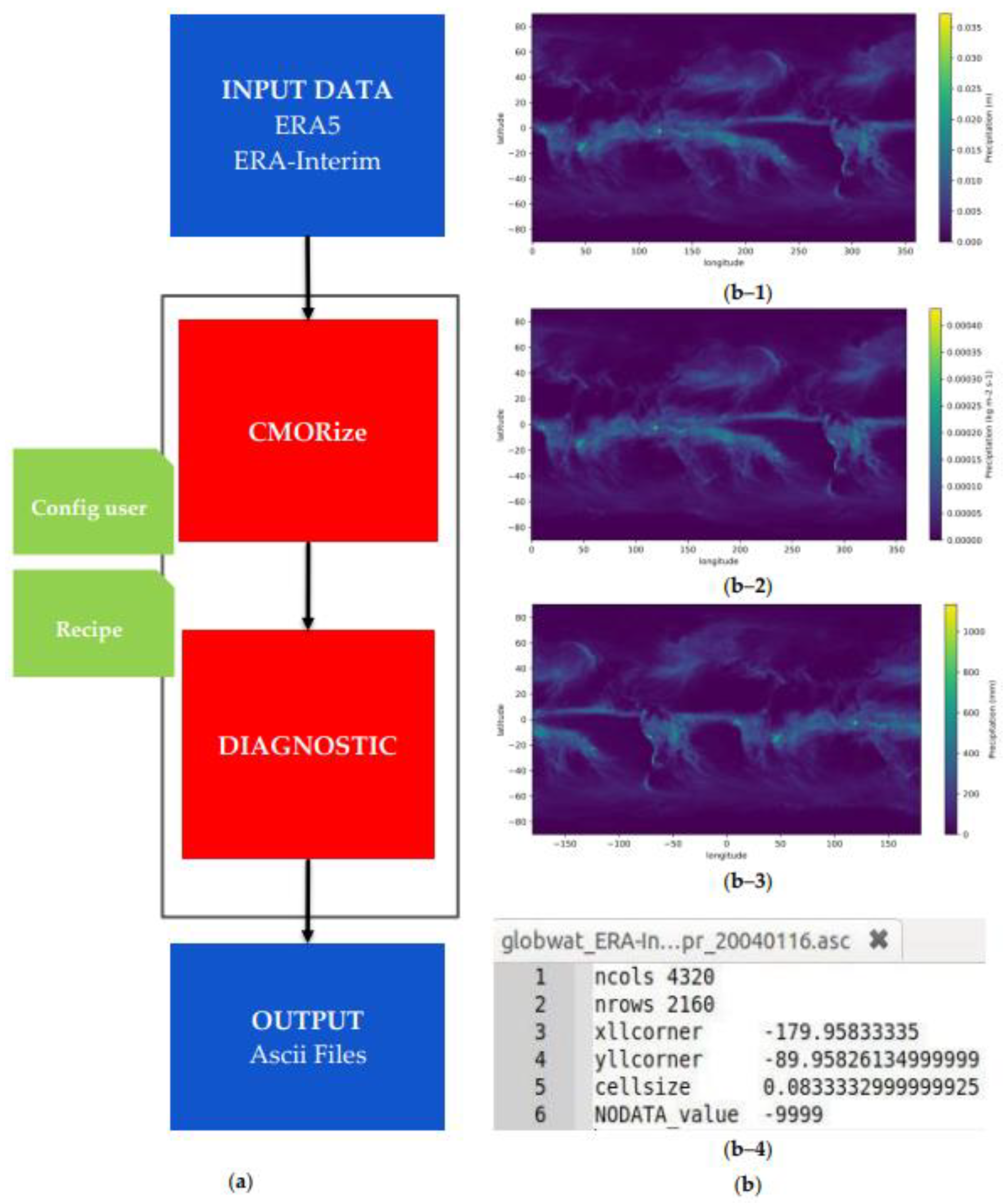

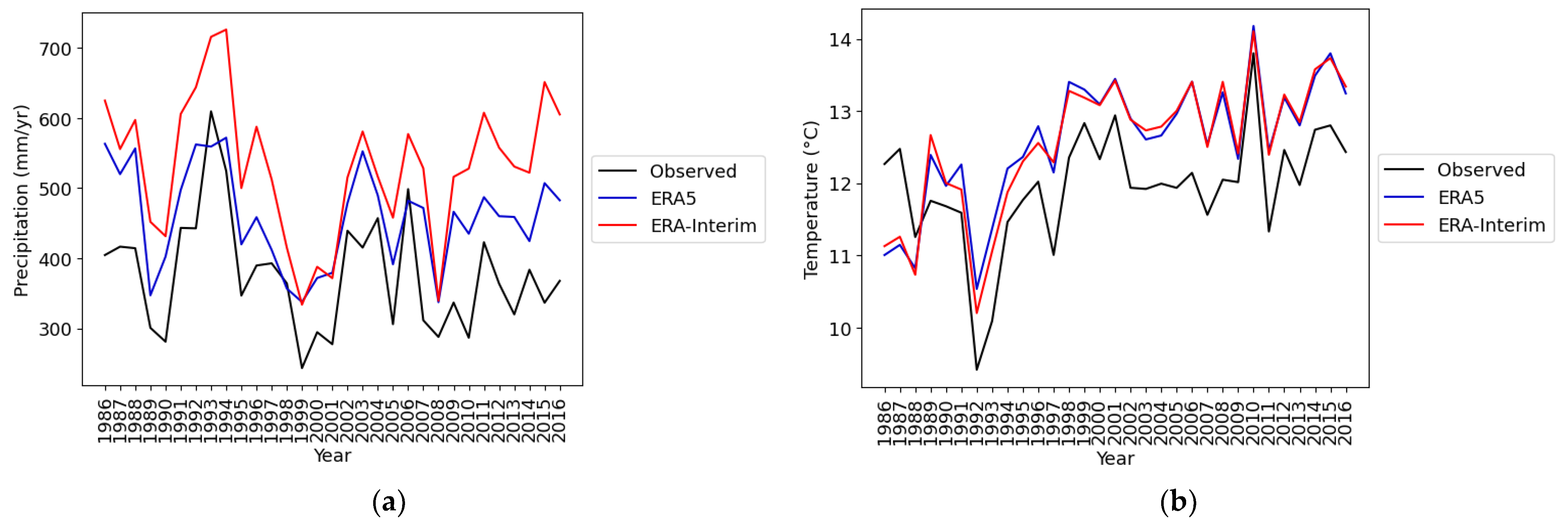
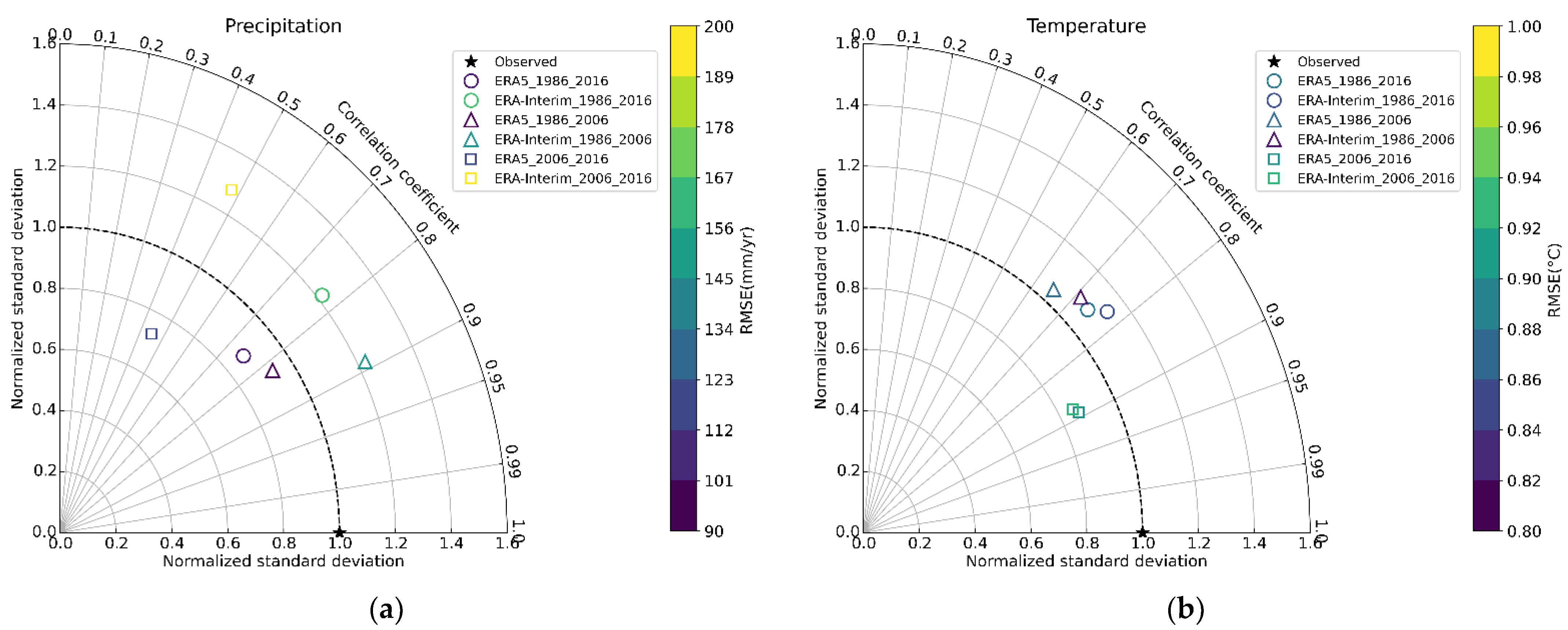
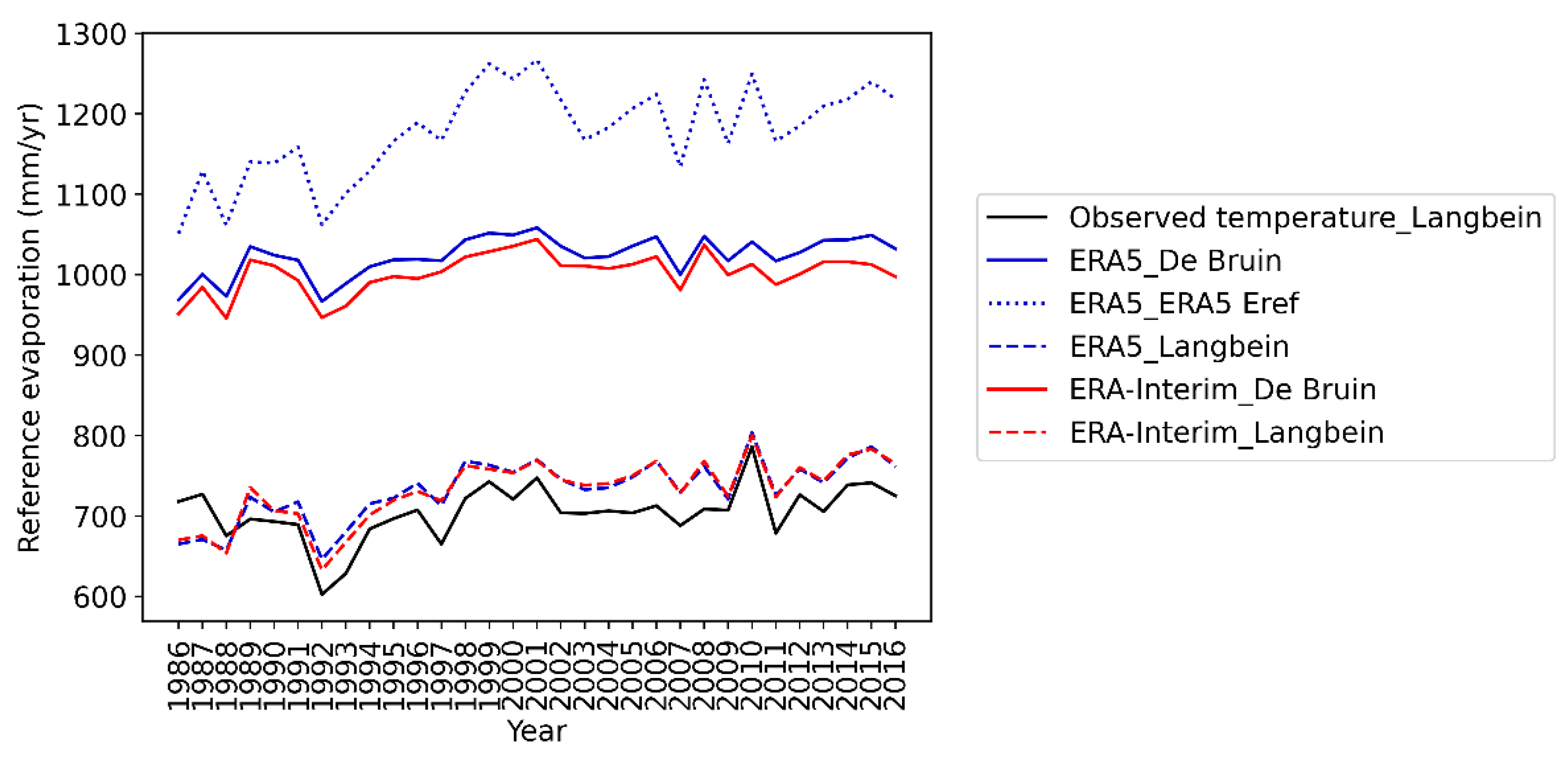


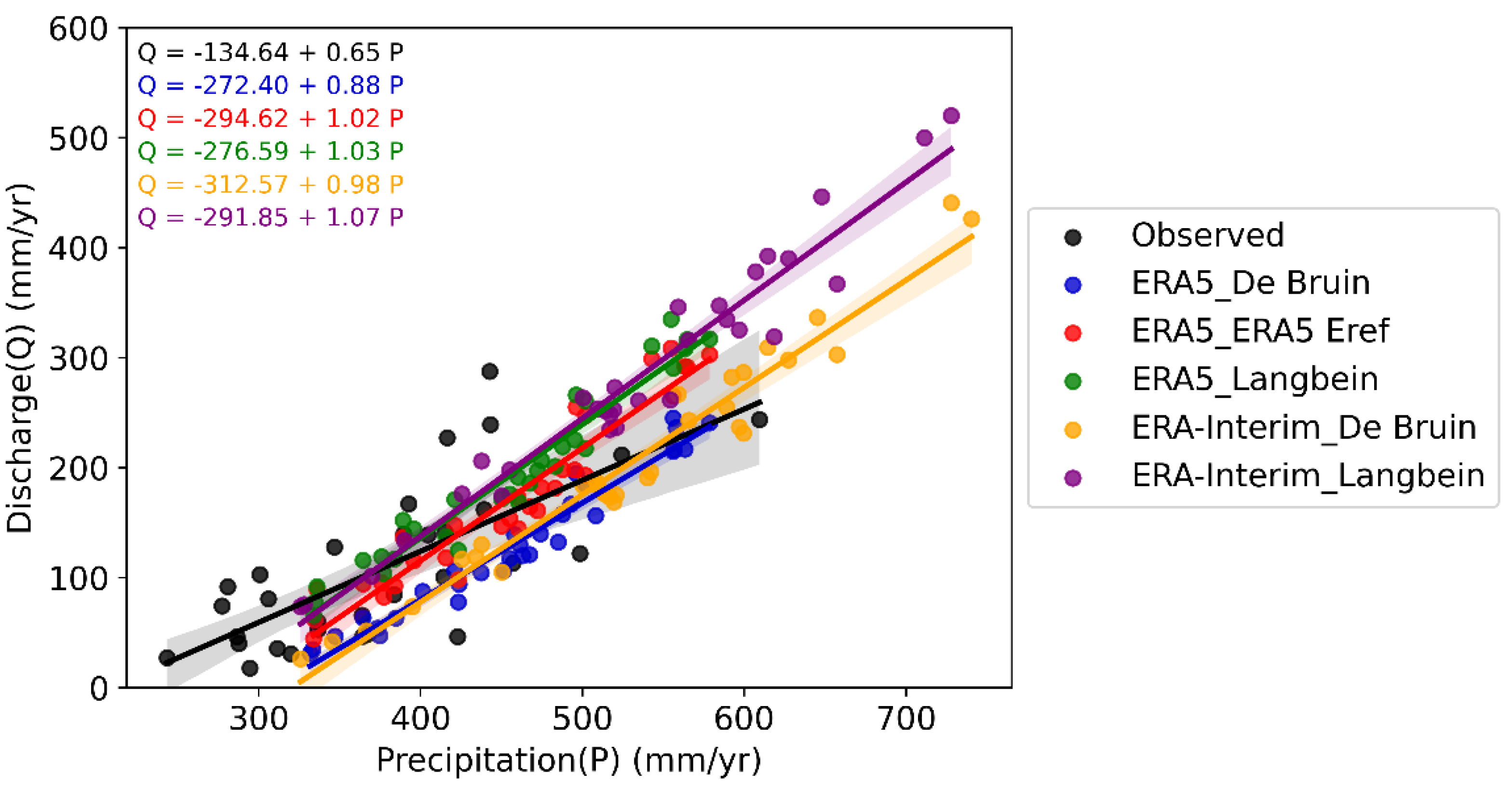

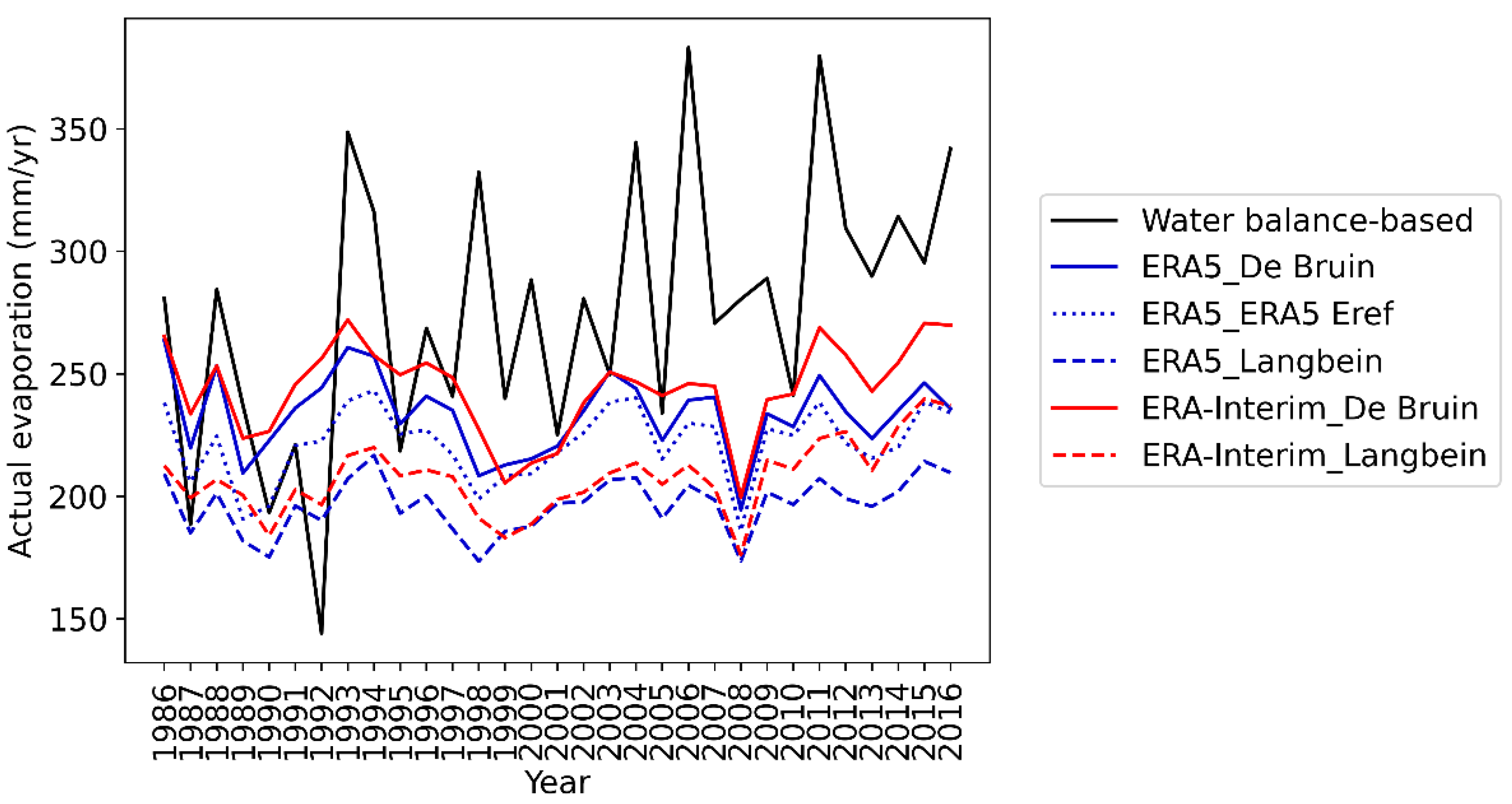
| File Type | Columns (X) | Rows (Y) | Pixel Size (Degree) | No Data Value | Data Type | Reference System | Extent |
|---|---|---|---|---|---|---|---|
| AAIGrid: Arc/Info ASCII Grid | 4320 | 2160 | 0.08333 | −9999 | Float32 | GCS WGS84 | −180; −90: 180; 90 |
| Time Period | Dataset | Eref Method | CC | RMSE (mm/yr) | Mean (mm/yr) |
|---|---|---|---|---|---|
| 1986–2016 | Observed | 1 | 0 | 275 | |
| ERA5 | De Bruin | 0.3 | 67 | 234 | |
| ERA5 Eref | 0.4 | 74 | 222 | ||
| Langbein | 0.5 | 93 | 197 | ||
| ERA-Interim | De Bruin | 0.4 | 60 | 244 | |
| Langbein | 0.5 | 83 | 208 | ||
| 1986–2006 | Observed | 1 | 0 | 257 | |
| ERA5 | De Bruin | 0.3 | 55 | 234 | |
| ERA5 Eref | 0.4 | 61 | 220 | ||
| Langbein | 0.5 | 79 | 195 | ||
| ERA-Interim | De Bruin | 0.2 | 54 | 241 | |
| Langbein | 0.4 | 73 | 203 | ||
| 2006–2016 | Observed | 1 | 0 | 309 | |
| ERA5 | De Bruin | 0.4 | 85 | 233 | |
| ERA5 Eref | 0.4 | 93 | 224 | ||
| Langbein | 0.5 | 115 | 200 | ||
| ERA-Interim | De Bruin | 0.5 | 71 | 249 | |
| Langbein | 0.4 | 100 | 217 |
Publisher’s Note: MDPI stays neutral with regard to jurisdictional claims in published maps and institutional affiliations. |
© 2022 by the authors. Licensee MDPI, Basel, Switzerland. This article is an open access article distributed under the terms and conditions of the Creative Commons Attribution (CC BY) license (https://creativecommons.org/licenses/by/4.0/).
Share and Cite
Abdollahi, B.; Alidoost, F.; Moshir Panahi, D.; Hut, R.; van de Giesen, N. ERA5 and ERA-Interim Data Processing for the GlobWat Global Hydrological Model. Water 2022, 14, 1950. https://doi.org/10.3390/w14121950
Abdollahi B, Alidoost F, Moshir Panahi D, Hut R, van de Giesen N. ERA5 and ERA-Interim Data Processing for the GlobWat Global Hydrological Model. Water. 2022; 14(12):1950. https://doi.org/10.3390/w14121950
Chicago/Turabian StyleAbdollahi, Banafsheh, Fakhereh Alidoost, Davood Moshir Panahi, Rolf Hut, and Nick van de Giesen. 2022. "ERA5 and ERA-Interim Data Processing for the GlobWat Global Hydrological Model" Water 14, no. 12: 1950. https://doi.org/10.3390/w14121950
APA StyleAbdollahi, B., Alidoost, F., Moshir Panahi, D., Hut, R., & van de Giesen, N. (2022). ERA5 and ERA-Interim Data Processing for the GlobWat Global Hydrological Model. Water, 14(12), 1950. https://doi.org/10.3390/w14121950






